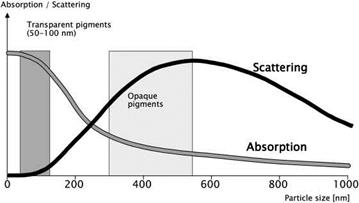Transparent inorganic pigments are conveniently divided into two groups: colored and colorless. The colorless pigments, which do not absorb in the visible light range, are functional nano-materials with specific properties that are described in the sections below. The colored pigments may also possess these functional properties.
The transparency and hiding power resulting from the light scattering of the applied pigment depend on the size of the pigment particles in the application medium and, in the case of pigments that do not absorb in the visible light range, on the difference between the refractive indices of the pigment and the binder. With increasing particle size, the scattering of a pigment per unit weight increases to a maximum, while the absorption per unit weight decreases as the total surface area decreases. To achieve maximum transparency with a given pigment, dispersion of the pigment must be as close to optimum as possible. Aggregates and agglomerates (DIN 53206 [5.184]) must be destroyed as the pigment is incorporated into the binder or plastic.
|
Fig. 5.35 Absorption and scattering by pigments as a function of particle size. |
The pigment must be present in the application medium largely as primary particles. The transparency of a colored pigment with a given chemical composition depends entirely on obtaining primary particles of a particular size during manufacture (Figure 5.35).
Colored pigments are transparent in clear binders if their particle size lies in the 2 to 15 nm range. If the particles are needle-shaped, the diameter in the direction of the light is the determining factor. In practice, the transparency of a pigmented system is expressed as in DIN 55988 [5.185] by the transparency value T, which is determined from the quotient of the path length or concentration h and the color difference AE* ab measured according to DIN 6174 [5.184] against an ideal black background.
5.4.1
 14 января, 2016
14 января, 2016  Pokraskin
Pokraskin 
 Опубликовано в рубрике
Опубликовано в рубрике 